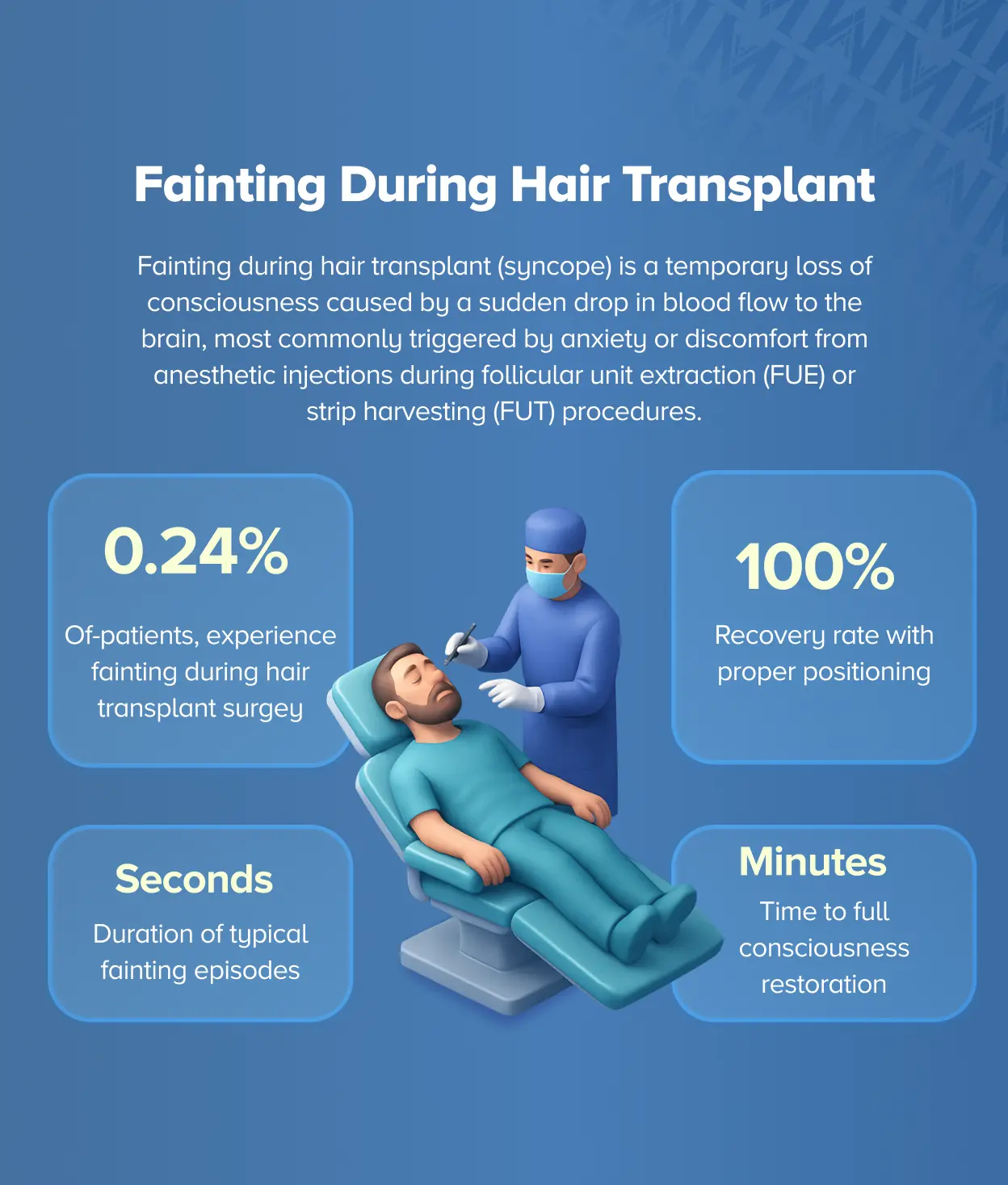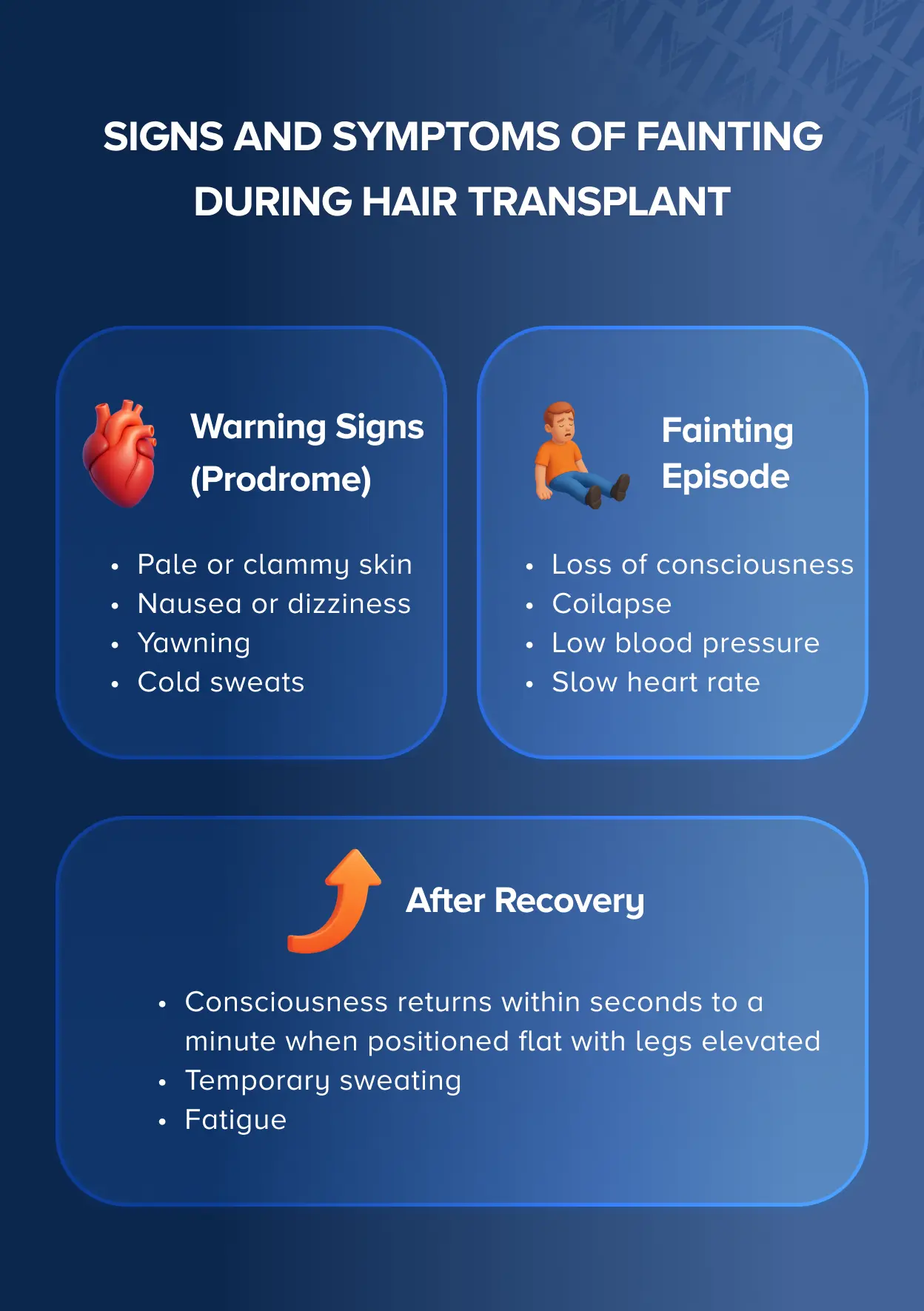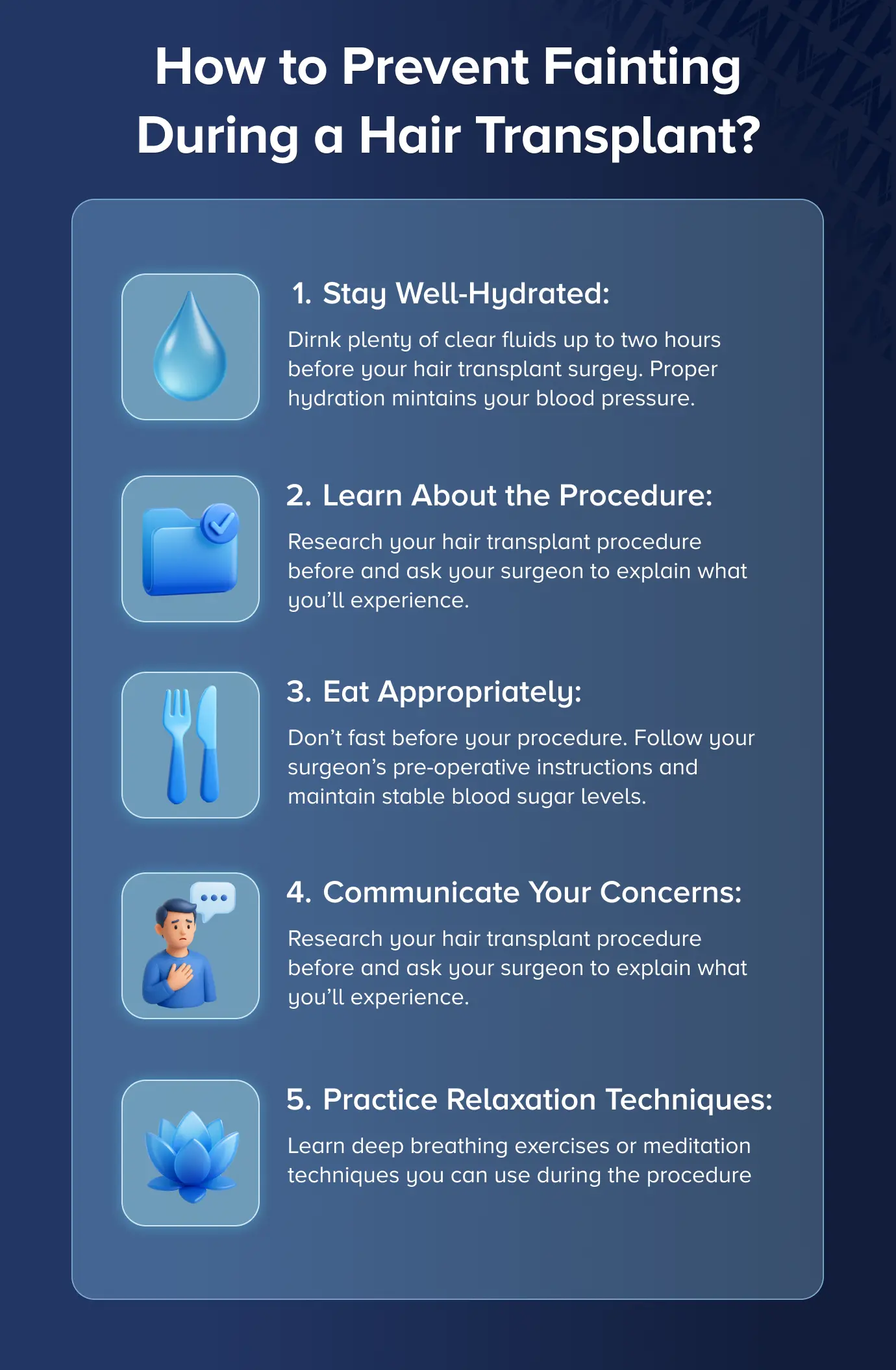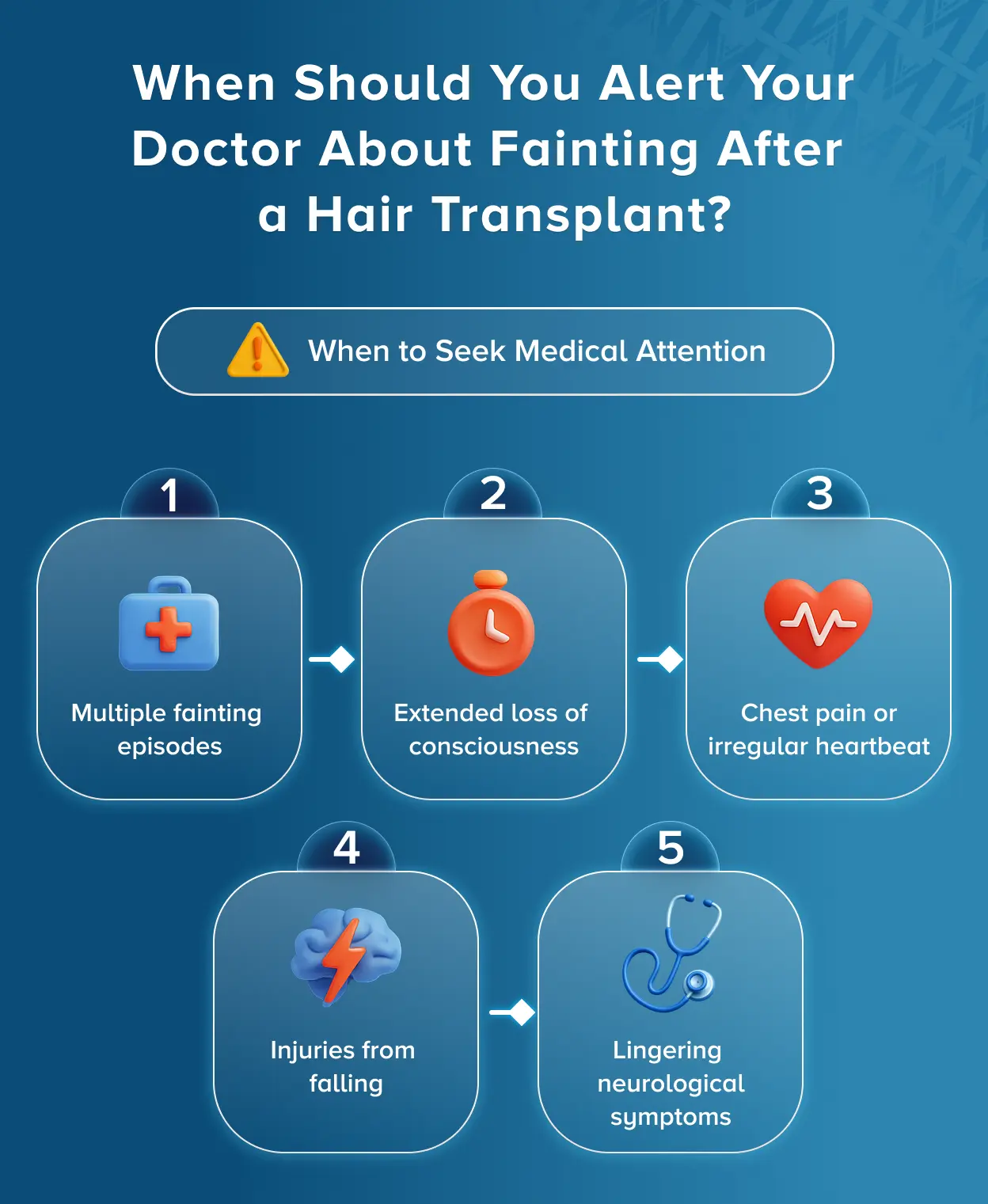
Fainting during a hair transplant (syncope) is a temporary loss of consciousness caused by a sudden drop in blood flow to the brain, most commonly triggered by anxiety or discomfort from anesthetic injections during follicular unit extraction (FUE) or strip harvesting (FUT) procedures. While fainting during hair transplant surgery is rare, affecting approximately 0.24% of patients, it can interrupt surgical procedures and potentially cause injuries from falls if not managed properly.
Understanding the causes, identifying patients who may be at risk, and implementing preventive measures ensures both safety and comfort during hair transplant surgery. Most fainting episodes resolve quickly when patients are repositioned with their legs elevated, allowing the procedure to continue safely.
Key Points
- Fainting is a temporary loss of consciousness caused by a sudden drop in blood flow to the brain during hair transplant surgery.
- Fainting after hair transplant is very rare, occurring in about 0.24% of patients (7 of 2,896 patients) in one study.
- Fainting episodes happen quickly and resolve within minutes when the patient lies down with legs raised.
- Fainting during hair transplant occurs when the body has a sudden reaction to pain or anxiety, triggered by the nervous system lowering heart rate and blood pressure.
- Patients with anxiety, needle phobia, high fitness levels, a history of fainting, or dehydration are more likely to experience fainting during hair transplant.
- Fainting episodes show signs like pale skin, low blood pressure, and slow heart rate, which improve quickly with proper positioning.
- Fainting during hair transplant can be prevented with proper hydration, distraction techniques, and gentle injection methods.
What is fainting during hair transplant?
Fainting during a hair transplant is a sudden, brief loss of consciousness caused by reduced blood flow to the brain. This typically occurs as a vasovagal reaction, where the nervous system responds to pain, anxiety, or emotional stress during the procedure. The body's automatic response increases vagal nerve activity and decreases sympathetic nervous system activity, resulting in a slower heart rate and widened blood vessels that cause blood pressure to drop rapidly.
In hair transplantation, fainting most commonly occurs during local anesthetic injection or when patient anxiety peaks. This represents a harmless event that resolves once the patient is repositioned and comforted.
What are the signs and symptoms of fainting during hair transplant?

Fainting during hair transplant often begins with warning signs before the actual loss of consciousness. Recognizing these prodromal symptoms allows medical teams to intervene early and prevent complications during the procedure.
- Warning Signs (Prodrome) - Pale or clammy skin, nausea or dizziness, yawning, and cold sweats that precede the actual fainting episode.
- During the Fainting Episode - Brief loss of consciousness, loss of muscle tone and collapse, low blood pressure and slow heart rate.
- After Recovery - Consciousness returns within seconds to a minute when positioned flat with legs elevated, temporary sweating and fatigue.
- Distinguishing Features - No confusion or lingering effects, distinguishing it from seizures or other serious conditions.
These characteristics help medical staff quickly identify and manage fainting episodes during hair transplant procedures, ensuring patient safety and procedural continuity.
How common is fainting during a hair transplant?
📊 Extremely Rare Occurrence
Fainting after hair transplant affects 0.24% of patients (7 out of 2,896 patients in one study), making it extremely rare. This low rate reflects both the generally mild nature of vasovagal reactions and the effectiveness of standard preventive measures used by experienced hair transplant teams.
Despite its rarity, every patient surgical team should be prepared to recognize and manage fainting promptly to avoid complications and ensure optimal surgical outcomes.
How long does fainting last during a hair transplant?
Fainting episodes during hair transplant are brief and self-limited, following a predictable timeline that allows for effective medical management and procedural continuation.
Onset
Typically occurs during or immediately after local anesthetic injection when pain or anxiety peaks
Duration
Loss of consciousness generally lasts seconds to under one minute
Recovery
Placing the patient flat with legs elevated quickly restores blood flow to the brain
Classification
These episodes are categorized as acute, self-limited vasovagal syncope
What causes fainting during hair transplant?
The most common triggers in hair transplantation are needle injections for local anesthesia and pre-procedure anxiety. Understanding this physiological cascade helps medical teams implement effective prevention and management strategies.
Triggering Stimulus
Pain from needle insertion, fear of needles, or emotional distress during the hair transplant procedure acts as the initial trigger.
Nervous System Response
The stimulus activates increased vagal (parasympathetic) nerve activity and decreased sympathetic nerve activity.
Heart and Blood Vessel Response
Increased vagal activity slows the heart rate, while decreased sympathetic activity causes blood vessels to widen, reducing blood pressure.
Recovery Mechanism
When the patient is positioned flat with elevated legs, blood return to the heart improves, normalizing blood pressure and restoring brain blood flow.
Who is more likely to faint during a hair transplant?
Certain factors increase the risk of fainting during hair transplant surgery, allowing medical teams to identify high-risk patients and implement preventive measures accordingly.
- High Procedural Anxiety - Patients with needle phobia or general anxiety about surgery often have exaggerated nervous system responses to perceived pain or stress.
- Painful Anesthetic Injections - Rapid, large-volume injections can intensify pain signals, provoking stronger vagal responses.
- High Baseline Vagal Tone - Physically fit individuals or athletes may have lower resting heart rates, making them more prone to slow heart rate responses.
- History of Prior Fainting Episodes - Patients who have fainted during blood draws or vaccinations are at higher risk during hair transplantation.
- Dehydration and Fasting - Inadequate pre-procedure hydration or extended fasting lowers blood volume, making blood pressure more susceptible to drops.
How do doctors diagnose fainting during hair transplant?
Fainting episodes during a hair transplant show clear signs that medical staff can quickly recognize and assess. The diagnostic process focuses on distinguishing normal vasovagal syncope from more serious conditions requiring immediate intervention.
Observable Signs During Episode
- Patient becoming pale, clammy, and dizzy before losing consciousness briefly
- Low blood pressure and slow heart rate typically evident during the event
- Measurements normalize when the patient is positioned flat
- Quick return to consciousness without prolonged confusion
When Further Evaluation is Needed
- Fainting recurs frequently or presents with unusual features
- Chest pain or prolonged recovery accompanies the episode
- Other cardiac or neurologic causes should be considered
- In straightforward cases, further testing like ECG or imaging is not routinely required
How serious is fainting during a hair transplant?
Most fainting episodes during hair transplant are harmless and temporary; however, secondary complications can occur that require proper management and prevention strategies.
⚠️ Potential Complications
• Falls and Injury: A fainting collapse from a surgical chair may lead to head trauma or scalp injuries if not anticipated by staff.
• Procedure Disruption: Fainting necessitates pausing the hair transplant to stabilize the patient, potentially prolonging operative time.
• Increased Anxiety: Experiencing fainting can heighten a patient's fear of medical procedures, complicating future surgical encounters.
• Rare Serious Complications: Significant falls can cause scalp bleeding or, very rarely, neck injury if the patient is not adequately supported.
Despite these risks, immediate and proper management of fainting episodes minimizes complications and ensures excellent outcomes for hair transplant procedures.
How to prevent fainting during a hair transplant?

✅ Prevention Strategies
Preventing fainting during hair transplant largely depends on proper preparation and communication with your surgical team:
- Stay Well-Hydrated: Drink plenty of clear fluids up to two hours before your hair transplant surgery. Proper hydration maintains your blood volume and reduces the risk of fainting when your blood pressure drops.
- Learn About the Procedure: Research your hair transplant procedure beforehand and ask your surgeon to explain what you'll experience. Understanding what to expect reduces anxiety, which is a major trigger for fainting episodes.
- Eat Appropriately: Don't fast for extended periods before your procedure. Follow your surgeon's pre-operative instructions about eating and drinking to maintain stable blood sugar levels.
- Communicate Your Concerns: Tell your surgical team if you have a history of fainting, needle phobia, or high anxiety. This allows them to take extra precautions and use gentler techniques during your procedure.
- Practice Relaxation Techniques: Learn deep breathing exercises or meditation techniques you can use during the procedure. Controlled breathing helps keep your nervous system calm during injections.
How is fainting treated during a hair transplant?
Immediate Response Protocol
- Immediate Positioning: Your doctor will quickly position you completely flat and elevate your legs 30°–45° to help blood flow return to your brain.
- Monitoring Your Recovery: Your medical team will closely monitor your blood pressure and heart rate to ensure they return to normal levels.
- Creating a Calm Environment: Once you regain consciousness, your doctor will explain what happened and reassure you that fainting is normal and harmless.
Supportive Care Measures
- Helping You Rehydrate: When you're fully alert, you'll be offered sips of water or clear liquids to help stabilize your blood sugar and restore hydration levels.
- Additional Treatment (If Needed): In rare cases where your heart rate remains very slow, your doctor may administer a medication called atropine through an IV.
- Careful Monitoring: Your medical team will continue observing you until your vital signs are completely stable.
Procedure Continuation
- Resuming Your Procedure: Most patients recover completely within minutes. Once you feel comfortable and your doctor confirms you're stable, your hair transplant procedure can typically continue safely.
When should you alert your doctor about fainting during a hair transplant?

⚠️ When to Seek Medical Attention
Although fainting during hair transplant is usually harmless, you should contact your doctor if you experience any of these concerning symptoms:
• Multiple Fainting Episodes: If you faint more than once during your procedure or at follow-up appointments, contact your doctor for a general medical evaluation to rule out heart or neurological conditions.
• Extended Loss of Consciousness: If you remain unconscious for more than two minutes despite being positioned flat with legs elevated, this requires immediate medical attention.
• Chest Pain or Irregular Heartbeat: If your fainting episode occurs with chest discomfort, heart palpitations, or irregular heartbeat, seek immediate medical care.
• Injuries from Falling: If you sustain any head injury, neck pain, or suspected bone fracture from falling when you fainted, get prompt medical evaluation.
• Lingering Neurological Symptoms: Contact your doctor immediately if you experience ongoing weakness, numbness, vision changes, or other neurological symptoms after fainting.
